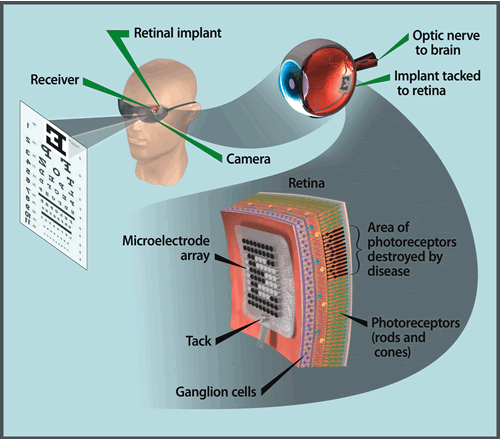Brain Machine Artifacts
Today our guest, Peyman Pakzaban, talks about the place where our brains and machines meet. The University of Houston presents this series about the machines that make our civilization run and about the people whose ingenuity created them.
The year was 2006. A quadriplegic man used his brain waves to move a cursor on a computer screen and operate a robotic arm. This was a major milestone in the field of brain-machine interface. Neurosurgeons had put electrodes in his brain to connect it to a computer.
The term brain-machine interface makes us think of science fiction characters that plug a computer into the back of their heads and upload and download information to their brains. But neuroscientists have more modest expectations. They want to make electronic devices called neural prostheses that replace functions lost to neurological diseases.
The first useful neural prosthesis was the cochlear implant. This is a device that is surgically placed in the inner ear of a deaf person. It translates sounds into discrete electrical impulses and sends them to the brainstem. Brain-machine scientists have since developed retinal prostheses that are implanted in a partially blind eye. They relay images from a camera to the optic nerve and brain. Most of the recent excitement has been about motor neural prostheses that quadriplegics might use to move robotic arms.
What makes brain-machine interface possible is that our biological brains and electronic machines use electricity as a common currency for exchange of information. But there are practical and theoretical limits to what can be achieved.
Why can't we transfer knowledge between our brains and computers? Why can't we make a memory prosthesis? It's because of the way our brains store memory. Each individual memory is formed by a specific pattern of connections between a specific set of neurons firing in a specific way. But with a hundred billion neurons in our brains, it's not practical to find the ones responsible for a particular memory and make electronic connections with them.
But don't despair. Technology has offered us a workaround - an extension of our brains in the palm of our hands. Smartphones have changed our thinking about memory prostheses. With portable internet, we can instantaneously access the sum-total of human knowledge with a few clicks on our smartphones. All we need to do is to make the interface more seamless. We could create motor neural prostheses to let our brains silently punch in questions on the internet device. The device could then reply back to our brains with private sounds and images through auditory and visual prostheses.
With our machine-connected brains, we will be more knowledgeable as individuals but not necessarily smarter. Knowledge is about having the right answers, but intelligence is about asking the right questions; and creativity is about asking questions to which there are no known answers. For these, we will still have to rely on our biological brains.
I am Peyman Pakzaban at Houston MicroNeurosurgery, where we're interested in the way inventive minds work.
How a retinal prosthesis works. Photoreceptor cells are like tiny cameras in the retina that convert light to electrical signals and send them to the brain. These cells are killed by diseases like macular degeneration and retinitis pigmentosa, causing loss of vision.
A retinal prosthesis is a brain-machine interface that bypasses the dead photoreceptor cells. It has an external camera that communicates with a microelectrode array on the retina. The microelectrode array sends electrical signals directly to the ganglion cells of the retina which, in turn, send the signal through the optic nerve to the brain.
Source: U.S. Department of Energy Office of Science, Artificial Retina Project.
References:
Brain-machine interfaces: past, present and future. Trends in Neurosciences 29, 9 (2006) Mikhail A. Lebedev, Miguel A.L. Nicolelis (http://www.sciencedirect.com/science/article/pii/S0166223606001470)
Is this the bionic man? Nature 442, 109 (13 July 2006) (http://www.nature.com/nature/journal/v442/n7099/full/442109a.html)
Artificial Retina Project: Restoring sight through science. U.S. Department of Energy Office of Science.
This episode was first aired on March 7, 2012
